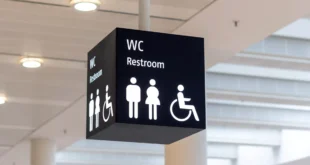Signage remains a crucial aspect of homes, businesses, and special events. As we live in a digitized world, digital signage has seen a rise in usage due to its sleek appearance and versatility.
Despite common misconceptions, both traditional and digital signage can coexist. While digital signage is suitable in certain situations, it may not always be the optimal choice. Traditional signage still holds numerous advantages over newer digital alternatives. Also, traditional signage is still a highly effective marketing tool for businesses needing custom signs.
While digital signs have their advantages, there are still several reasons why traditional signage is a better choice.
1. Authenticity
One of the main advantages of traditional signage is its authenticity. Traditional signs are often handmade or crafted by skilled artisans, and as a result, they have a unique, authentic quality that cannot be replicated by digital signs. Traditional signs also have a classic appeal that never goes out of style.
2. Reliability
Traditional signs are made from durable materials that are designed to withstand the elements. They are also not dependent on electricity or other technical components, making them more reliable in emergency situations. Digital signs, on the other hand, require regular maintenance and can be affected by power outages or other technical issues.
3. Visibility

Traditional signs are often larger and more prominent than digital signs, making them more visible from a distance. This is especially important for businesses located on busy streets or in crowded areas. Traditional signs are also not affected by glare or other lighting issues that can make digital signs difficult to read.
4. Versatility
While digital advertising is incredibly versatile, it’s important to note that it has several limitations. It requires a power supply, must be protected from exposure to the elements and water, and needs a sturdy surface for mounting. These requirements can make it difficult to use digital signage in certain settings, such as in the middle of a local park.
Traditional signage can be set up virtually anywhere without any special requirements. Weather-resistant mesh banners are designed to allow wind to pass through, and free-standing corrugated plastic signs can be placed on any solid ground surface. You don’t need any special utilities to use them, and they are not prone to damage from exposure to the elements.
5. Memorability
Traditional signs are often more memorable than digital signs. This is because traditional signs are designed to be seen and remembered, while digital signs are often viewed quickly and then forgotten. In addition, traditional signs can create an emotional connection with customers, which can lead to increased loyalty and repeat business.
6. Cost-effectiveness

When it comes to cost, traditional signage such as aluminum signs, mesh, and paper posters are more affordable to produce than digital LED screens. Therefore, if you have a limited budget, it’s advisable to opt for traditional signage rather than digital.
Although it’s a commonly held belief that digital signage is more cost-effective over time due to its versatility and durability, this is not always the case. With proper maintenance, traditional signage can last up to five years or more. Furthermore, if your designs are static, versatility is not a crucial factor. Additionally, in the event of damage, the cost to replace traditional products is significantly less than buying brand-new digital hardware.
By knowing your requirements and preferences, choosing traditional signage can save you a considerable amount of money.
7. Environmentally Friendly
Traditional signs are an environmentally friendly choice compared to digital signs. Digital signs require electricity to operate, which can lead to increased energy consumption and carbon emissions. Traditional signs, on the other hand, can be made from sustainable materials and are often crafted by hand, reducing the environmental impact of production.
8. Cultural Significance
Traditional signs can also have cultural significance and serve as a testament to a community’s history and heritage. In some areas, traditional signage is a part of the local culture and can attract tourists and visitors interested in learning more about the area’s traditions and customs.
9. Unique Aesthetic
Traditional signs have a unique aesthetic that is hard to replicate with digital signage. The use of handcrafted materials, vintage lettering, and traditional design elements can create a sense of nostalgia and evoke a bygone era. This can be especially effective for businesses that want to appeal to a certain demographic or create a unique brand identity.
10. Personal Touch
Traditional signs often have a personal touch that is lacking in digital signs. The process of designing and creating a traditional sign involves a level of craftsmanship and attention to detail that can be lost in the digital realm. Traditional sign makers can work with businesses to create custom designs that reflect their brand and values, creating a personal connection between the business and the sign.
11. Ease of Maintenance

Maintenance is required for both digital and traditional signage, but traditional signage requires simpler and lighter maintenance, such as cleaning and basic material care. These tasks can be easily done and are typically free of charge.
Maintaining digital media is a much more complex and costly process than traditional signage. It requires hiring a specialist, which results in several days of downtime without access to the product. While digital media also needs cleaning, traditional media requires simpler and less expensive maintenance. These are just a few of the advantages that traditional media offers over modern digital technology.
12. Emotional Appeal
Traditional signs have an emotional appeal that digital signs cannot replicate. The use of natural materials, unique designs, and handcrafted elements can create a sense of warmth and nostalgia that is hard to achieve with digital signs. This emotional connection can lead to increased customer loyalty and a stronger connection between the business and its customers.
13. Durability
Traditional signs are often more durable than digital signs. They are made from high-quality materials designed to withstand harsh weather conditions, making them a reliable choice for businesses in areas with extreme weather. Traditional signs also have a longer lifespan compared to digital signs, reducing the need for frequent replacement and lowering overall costs.
14. Timelessness
Traditional signage has a classic look and feel that has been used for decades. This type of signage provides a sense of history and permanence to a location or business. The use of materials like wood, metal, and stone gives traditional signage a sense of timelessness that digital signage cannot match. Traditional signage is often associated with high-end or classic establishments, and it can add a sense of elegance and sophistication to a location.
In contrast, digital signage can often feel more transient and temporary. It can be easily updated and changed, which can make it feel less permanent. This can be beneficial in certain situations where information needs to be updated frequently, but it can also detract from the sense of history and permanence that traditional signage can provide. Additionally, the use of screens and LED lights can make digital signage feel more like a temporary advertisement rather than a permanent fixture of a location.
15. Artistic Value
Traditional signs can be viewed as works of art, with their unique designs and handcrafted elements. This artistic value can enhance the overall aesthetic of a business and create a sense of sophistication and elegance. Traditional signs can also be used as a focal point in a space, drawing attention and creating a memorable experience for customers.
Conclusion
While digital signage has its benefits, traditional signage still holds several advantages. Traditional signage is often more cost-effective, customizable, mobile, versatile, easier to maintain, and offers a sense of timelessness that digital signage cannot match. Traditional signage offers a classic and elegant look that adds a sense of history and permanence to a location or business, while digital signage can often feel more temporary and transient. Therefore, it’s essential to consider your specific requirements and preferences when choosing between traditional and digital signage to make the optimal choice for your situation. Both options can coexist, and each has its unique benefits that can be utilized for various purposes.
 Imagup General Magazine 2024
Imagup General Magazine 2024



